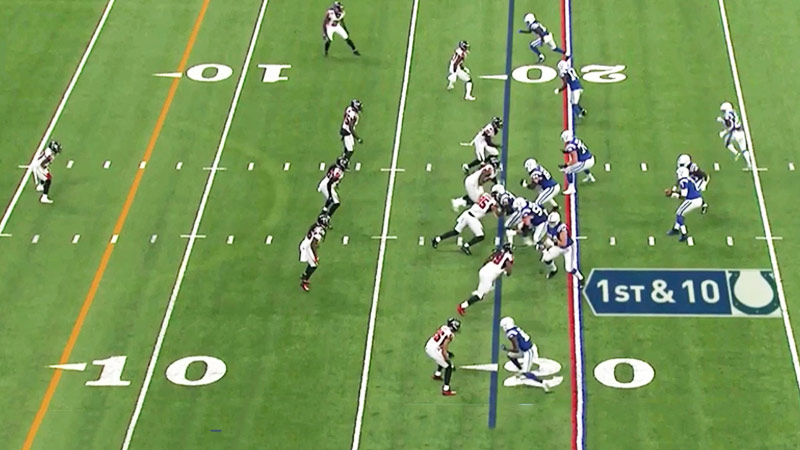In the dynamic world of American football, strategies and plays evolve constantly to outwit opponents and gain a competitive edge.
One such play that has garnered attention for its simplicity and effectiveness is the “bubble screen.”
Whether you’re a seasoned football fan or just beginning to delve into the intricacies of the game, understanding the mechanics and impact of a bubble screen can provide valuable insights into the strategic chess match that unfolds on the field. So, stay focused.
What Is a Bubble Screen in Football?
A bubble screen in football is a short passing play often used in the passing game. It involves the quarterback quickly throwing the ball to a wide receiver positioned near the line of scrimmage, usually at the edge of the offensive formation.
The receiver’s aim is to catch the ball and then receive blocking from other offensive players to create an opportunity for yardage gain. The play is designed to exploit the defense’s positioning, with the intention of allowing the receiver to find space and potentially make a quick run up the field.
Bubble screens are considered high-percentage passes and are often used as an extension of the running game, with the goal of gaining positive yards and advancing the ball down the field efficiently.
How Does a Bubble Screen Work in Football?
A bubble screen in football is a simple yet effective passing play designed to exploit the defense’s positioning and create an opportunity for yardage gain. Here’s how it typically works:
Formation
The offense lines up with a wide receiver (usually a slot receiver) positioned close to the line of scrimmage on one side of the formation. The quarterback is in the shotgun formation, a few yards behind the line of scrimmage.
Snap and Quick Pass
When the ball is snapped, the quarterback quickly throws a short and accurate pass to the wide receiver. The pass is usually a quick, lateral throw that doesn’t travel far forward, ensuring that it’s legal and not considered a forward pass.
Blocking
As soon as the receiver catches the ball, the offensive linemen and potentially other wide receivers engage in blocking to create a path for the receiver to run up the field.
This blocking is crucial to the play’s success, as it helps to create a lane for the receiver to advance without being tackled immediately.
Receiver’s Decision
Upon catching the ball, the wide receiver has the option to either make a quick run up the field or assess the situation. If the blocking is effective and there’s space, the receiver can accelerate and try to gain yards.
If the defense reacts quickly or if the blocking isn’t sufficient, the receiver might consider a lateral pass to another eligible receiver, essentially turning the play into a double pass or trick play.
Timing and Coordination
The success of the bubble screen depends on the timing and coordination between the quarterback, the receiver, and the blockers. The pass must be released quickly and accurately, and the blockers need to create a clear path for the receiver to exploit.
Defensive Reaction
Defenses have various ways to counter the bubble screen. They can choose to press the receiver at the line of scrimmage to disrupt the timing, send blitzes to pressure the quarterback, or have defensive backs and linebackers react quickly to the play to minimize yardage gain.
Yardage Gain
The primary goal of the bubble screen is to gain positive yardage and move the ball down the field efficiently. If executed well, the receiver can quickly turn upfield and pick up several yards before the defense can react.
The bubble screen is often used as an extension of the running game, providing a higher-percentage alternative to traditional handoffs while also exploiting potential gaps in the defense.
When Should A Bubble Screen Pass Is Used?
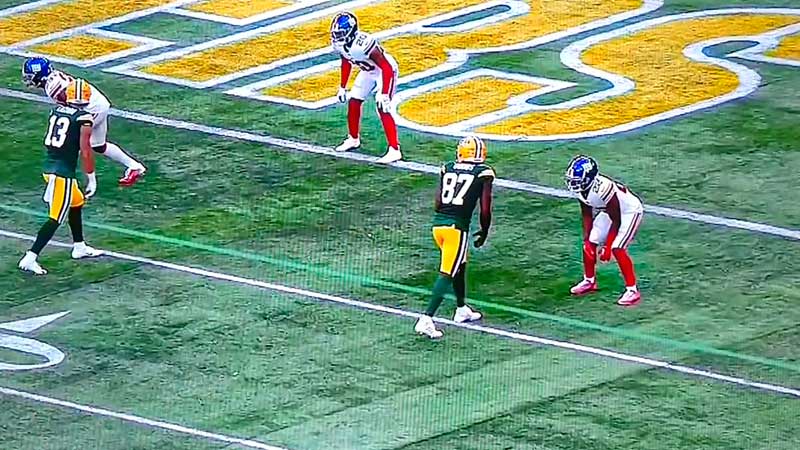
A bubble screen pass should be used strategically based on the game situation, defensive alignment, and offensive game plan. Here are some scenarios in which a bubble screen pass can be effectively employed:
Against Press Coverage
If the defense is playing press coverage on the wide receivers, a bubble screen can be used to take advantage of the space between the defensive backs and the line of scrimmage.
The quick lateral pass can help the receiver get the ball in open space and potentially break tackles for extra yardage.
To Counter Blitzes
When the defense is sending blitzes to pressure the quarterback, a well-timed bubble screen can neutralize the rush by quickly getting the ball out of the quarterback’s hands. The blocking setup can then create opportunities for the receiver to exploit the open field.
Early Downs and Distances
Bubble screens are often effective on early downs and short-yardage situations. They provide a safe and efficient way to gain positive yards without taking significant risks.
Against Soft Coverage
If the defense is playing off the line of scrimmage, providing cushion to the receivers, a bubble screen can be used to quickly get the ball into the hands of a playmaker. The receiver can catch the ball and potentially make a move to gain additional yards after the catch.
To Set Up Play Action
Running bubble screens can set up play-action passes later in the game. The defense starts to react to the quick screens, and this can open up opportunities for deeper passing plays off play-action fakes.
In the Red Zone
Bubble screens can be effective in the red zone, where the field is condensed. The quick pass can catch the defense off guard, and with effective blocking, the receiver has a chance to score a touchdown or gain valuable yards close to the end zone.
To Involve Speedy Receivers
If a team has a fast and agile receiver who excels in open-field situations, a bubble screen can be an excellent way to get them the ball with a chance to create a big play.
Against Aggressive Defenses
Against defenses that tend to aggressively pursue the quarterback or the running back, the bubble screen can exploit their aggressiveness and turn it into a vulnerability by using misdirection and quick lateral passes.
It’s important for coaches and quarterbacks to assess the defensive alignment, recognize tendencies, and make quick decisions on whether a bubble screen pass is the right play in a given situation.
What Is a Bubble Screen Pass in Football?
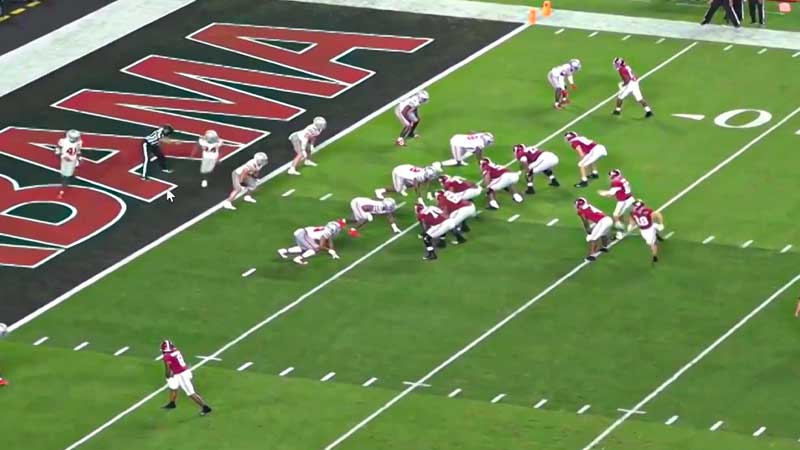
A bubble screen pass in football is a short, quick pass play that involves the quarterback throwing the ball to a wide receiver positioned near the line of scrimmage, often at the edge of the offensive formation.
The primary objective of a bubble screen is to get the ball into the hands of a playmaker in open space, with the intention of creating a favorable matchup against the defense and gaining positive yardage.
Key characteristics of a bubble screen pass include:
Quick Release
The quarterback releases the ball rapidly after receiving the snap, usually within a few seconds. This quick release is essential to prevent the defense from reacting in time to disrupt the play.
Lateral Pass
The pass is typically thrown laterally or slightly backward, which allows the receiver to catch the ball behind or near the line of scrimmage. This lateral nature of the pass ensures that it’s legal and not considered a forward pass.
Blocking
As the receiver catches the ball, the offensive linemen and potentially other receivers engage in blocking to create a clear path for the receiver to advance. Effective blocking is crucial for the success of the play, as it helps the receiver break free from defenders and gain yardage.
Yards After Catch (YAC)
The goal of the bubble screen is to generate yards after the catch. Once the receiver has the ball, they have the option to use their agility, speed, and elusiveness to evade defenders and gain additional yardage.
Optionality
Depending on the defensive alignment and the receiver’s assessment of the situation, there’s often an option for the receiver to make a quick decision. If the blocking and spacing are favorable, the receiver can attempt to gain yardage up the field. If the defense reacts quickly, the receiver might opt for a lateral pass to another eligible receiver or even throw the ball downfield if a legal passing option is available.
Misdirection
Bubble screens can be effective as a misdirection play, where the defense is manipulated into overcommitting to one side of the field, allowing the receiver to exploit the open space on the other side.
Bubble screens are used to extend the passing game, providing an alternative to traditional running plays. They are particularly effective against defenses that play off the line of scrimmage or when the offense wants to exploit the speed and agility of their playmakers.
What Is a Bubble Route in Football?
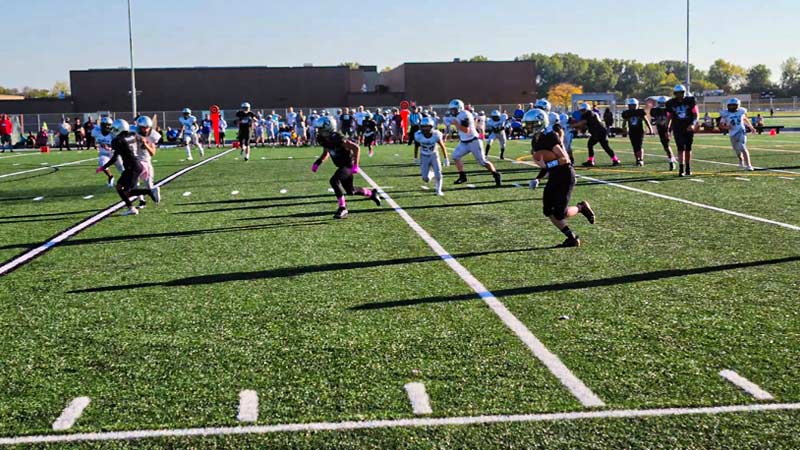
A bubble route in football refers to a specific pass route that a wide receiver runs during a passing play. It is commonly used as a part of various passing concepts to exploit defensive coverages and create opportunities for the offense to gain yardage.
In a bubble route:
Route Path
The wide receiver initially takes a step or two directly toward the line of scrimmage and then quickly changes direction to move laterally, parallel to the line of scrimmage. This lateral movement allows the receiver to receive a quick, short pass from the quarterback.
Timing
The quarterback’s throw is designed to arrive at the receiver as they make their lateral move or just as they’re starting to move upfield after catching the ball.
Spacing
The key element of the bubble route is spacing. The receiver aims to position themselves at a point where they are a few yards away from the nearest offensive lineman and just behind the line of scrimmage.
This positioning ensures that the pass is caught behind or near the line of scrimmage, making it a lateral pass.
Blockers
Offensive linemen and potentially other receivers on the same side of the field often serve as blockers for the receiver running the bubble route. Their role is to create a path for the receiver to run upfield after catching the pass.
Yards After Catch (YAC)
Like the bubble screen, the bubble route’s success often relies on the receiver’s ability to make defenders miss and gain additional yards after the catch. The lateral movement and spacing can help the receiver find open space to exploit.
The bubble route is often used in conjunction with other pass routes to keep the defense off-balance. It can be a part of various offensive formations and game plans, including quick-passing schemes and play-action plays.
Impact of Bubble Screen on Football
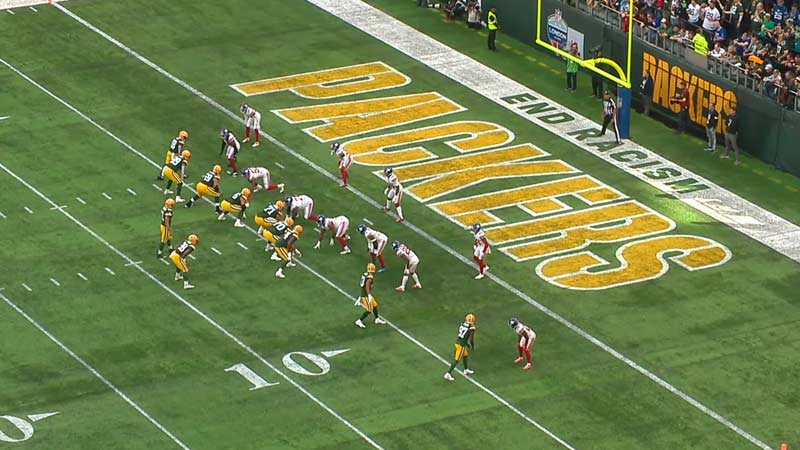
The bubble screen in football has several impacts on the game, both strategically and tactically. Its influence extends to various aspects of offensive and defensive strategies:
Exploiting Defensive Alignment
Bubble screens are designed to take advantage of the defensive formation. If the defense is playing off the line of scrimmage or if there’s a gap in coverage on the edge, the offense can capitalize on these weaknesses by quickly executing a bubble screen.
This can force defenders to move laterally and create space for the receiver to gain yardage.
Quick Ball Movement
Bubble screens facilitate quick ball movement from the quarterback to the receiver. This helps the offense get the ball into the hands of playmakers in open space, making it difficult for defenders to react in time. The rapid release of the ball can also neutralize the defense’s pass rush.
Extension of Running Game
Bubble screens serve as an extension of the running game. Instead of relying solely on traditional rushing plays, teams can use bubble screens to gain yards in a controlled and efficient manner.
This diversity in offensive options keeps the defense guessing and prevents them from stacking the box against the run.
Blocking and Blocking Schemes
The success of a bubble screen relies heavily on effective blocking by offensive linemen, receivers, and potentially tight ends. This puts emphasis on proper blocking techniques and coordination. The play helps teams refine their blocking schemes and enhances overall teamwork.
Yards After Catch (YAC)
One of the key impacts of a successful bubble screen is the potential for significant yards after the catch. Skilled receivers can use their agility and speed to evade defenders and turn a short pass into a substantial gain. This impacts field position and provides an offensive boost.
Defensive Adjustments
Defenses need to adapt to the threat of bubble screens. They may adjust their alignment and coverage responsibilities to counter the play. This can create opportunities for the offense to exploit the defense’s adjustments with other pass plays or misdirections.
Setting Up Other Plays
Running bubble screens can set up other plays, such as play-action passes. If the defense starts focusing on defending the bubble screen, it can create openings for deeper passing routes or runs up the middle.
Time of Possession and Clock Management
Successful execution of bubble screens can help sustain drives by converting short passes into positive gains. This extends the time of possession, limits the opposing offense’s opportunities, and aids in clock management.
Adapting to Defensive Strategies
As defenses adjust to counter bubble screens, offenses must respond by using variations of the play, incorporating pre-snap motions, or even using double passes to keep the defense guessing.
The impact of the bubble screen in football is multifaceted. It influences offensive strategies, defensive reactions, and the dynamic between the two sides of the game.
FAQs
What is a bubble screen in football?
A bubble screen is a short passing play designed to exploit defensive positioning. It involves the quarterback quickly throwing the ball to a receiver stationed near the line of scrimmage, who then looks to gain yardage with the help of blocking from teammates.
How does a bubble screen work?
A bubble screen entails the quarterback making a quick, lateral pass to a receiver who is already in motion. The receiver catches the ball and aims to capitalize on blocking assistance from the offensive line and fellow receivers. The goal is to create an opportunity for yards after the catch.
When should a bubble screen pass be used?
Bubble screens are strategic tools employed in various scenarios, including against press coverage, to counter blitzes, on early downs, and in the red zone. These plays capitalize on the defense’s positioning and aim to create quick, positive yardage gains.
What impact does a bubble screen have on the game?
A successful bubble screenplay has multiple impacts. It extends the passing game, serves as an extension of the running game, influences defensive adjustments, and can set up other plays like play-action passes. It also emphasizes blocking techniques and teamwork.
How do bubble screens adapt to defensive reactions?
As defenses adapt to defend against bubble screens, offenses respond with variations, pre-snap motions, and even double pass options. This strategic back-and-forth highlights the dynamic nature of football gameplay.
Wrapping Up
The bubble screen is more than just a simple play; it’s a testament to the strategic complexity that underpins football.
By providing a controlled way to gain yardage and exploit defensive vulnerabilities, the bubble screen showcases the innovative thinking that coaches and players bring to the field.
So, whether you’re watching a game unfold or discussing football strategies with fellow fans, understanding the role and impact of a bubble screen adds an extra layer of appreciation for the tactics at play in America’s favorite sport. Thank you for your time.

